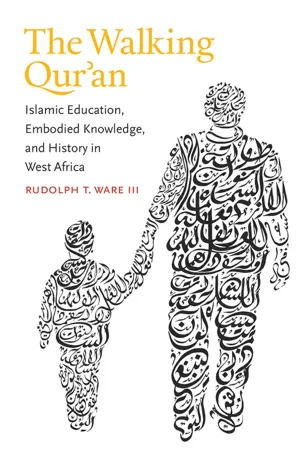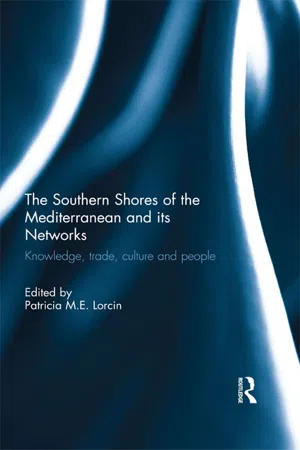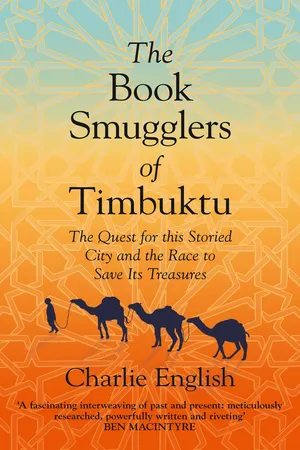History
University of Timbuktu
The University of Timbuktu was a renowned center of learning in the city of Timbuktu, Mali, during the medieval period. It flourished between the 13th and 17th centuries and attracted scholars and students from across the Islamic world. The university was known for its extensive libraries, which housed valuable manuscripts on various subjects, including science, mathematics, and Islamic studies.
Written by Perlego with AI-assistance
Related key terms
5 Key excerpts on "University of Timbuktu"
- eBook - ePub
Babel Unbound
Rage, reason and rethinking public life
- Rory Bester, Anthea Garman, Indra Lanerolle, Susana Molins Lliteras, Nomusa Makhubu, Litheko Modisane, Pascal Newbourne Mwale, Camalita Naicker, Lesley Cowling, Carolyn Hamilton(Authors)
- 2020(Publication Date)
- Wits University Press(Publisher)
There was a will to establish the truth about the pre-colonial past and to restore and acknowledge African contributions to human civilisation. 89 Thus, the insertion of the ‘Timbuktu archive’ into this public discourse about history was not surprising. As De Moraes Farias argues, the Sahel has always been a place for the formulation and reformulation of notions of African identity, since as a region it offers concrete proofs of the historical richness of Africa and thus has great symbolic value. 90 Mbeki in his ‘African Renaissance Statement’ (13 August 1998) drew on the iconic value of Timbuktu: ‘As we recall with pride the African scholar and author of the Middle Ages, Sadi of Timbuktu, who had mastered such subjects as law, logic, dialectics, grammar and rhetoric, and other African intellectuals who taught at the University of Timbuktu, we must ask the question – where are African intellectuals today?’ 91 The language of the discourse refers as much to the past as to the present. The idea of ‘renaissance’ implies a process of greatness-decay-recovery in the present, which always runs the risk of mystifying the past. 92 In incorporating Timbuktu to the ‘African Renaissance’ discourse, much of its uniqueness is masked by the homogeneity of the rhetoric. 93 For example, the notion of the ‘University of Timbuktu’ used by Mbeki in his speech and widespread in public discourse obscures the unique nature and traditions of higher knowledge production and transmission in the region, which were not institutionally centred, as medieval European universities were, nor based on the Islamic model of pious endowments (waqf) attached to mosques in the other Islamic regions. 94 It seems that the model of higher Islamic education widespread in Timbuktu and the West African region was based on a network of (sometimes mobile) scholars and the learning circles organised around them, perhaps sharing a common ‘core curriculum’ - eBook - ePub
Information Science
The Basics
- Judith Pintar, David Hopping(Authors)
- 2022(Publication Date)
- Routledge(Publisher)
1 COLLECTING INFORMATION
DOI: 10.4324/9781003155119-1In the summer of 2012 in the city of Timbuktu, a library housing hundreds of thousands of rare, handwritten manuscripts was threatened by an Al Qaeda-allied terrorist group intent on burning it to the ground. Nearly a half-century earlier, the United Nations Educational, Scientific, and Cultural Organization (UNESCO) had helped to create the Mamma Haidara Institute, named after a self-taught scholar whose family had been collecting manuscripts since the 15th century. Haidara’s son, Abdel Kader Haidara, inherited the family mission, sought professional training, and continued the effort, shared by many others, to locate and preserve the manuscripts that are the priceless heritage of the nation of Mali.1Timbuktu was founded in the 11th and 12th centuries by Tuareg tribes. By the 15th century the city had become a trading center on the trans-Saharan caravan route, and by the 16th had a thriving intellectual community centered around a mosque and a university that attracted scholars from across Africa and the known world. The city’s collections, written mostly in Arabic, contained works of broad and liberal subject matter, from history to theology, to astronomy to poetry. Even when the city’s geopolitical prominence waned, these manuscripts were preserved, copied, and held by the city’s first families, which passed them down through the generations in their private homes.There had been enough warning of the impending attack that the institute’s librarians, with the help of friends, family members, and library volunteers, were able to secretly pack thousands of items from the collections into small metal boxes before the library was destroyed.2 The boxes were moved via donkey cart and ATV, by twos and threes, hidden under fruit and vegetable crates, and then transported by bus, truck, or canoe along the Niger River to Mali’s capital city, Bamako, or to safe houses throughout the region. Reports vary, but it is possible that as many as 300,000 manuscripts were saved.3 - eBook - ePub
The Walking Qur'an
Islamic Education, Embodied Knowledge, and History in West Africa
- Rudolph T. Ware(Author)
- 2014(Publication Date)
- The University of North Carolina Press(Publisher)
35 Both chronicles make it clear that the town’s best and brightest scholars during the fourteenth and fifteenth centuries were black.The embodiment of this early black tradition of scholarship was Muḥ ammad al-Kā barī (d. 1450). Moodibo Muḥ ammad was likely of Fulɓ e, Soninke, or perhaps even Mandingo background. Like many West Africans, he may well have been of mixed-ethnic parentage. Whatever the case, he was very clearly dark-skinned, according to al-Saʿ adi, and just as clearly the most famous teacher of the early fifteenth century in Timbuktu.Among the revered men of Sankore was this shaykh, I mean thefaqī hMoodibo Muḥ ammad al-Kā barī the pre-eminent shaykh. . . . He settled in Timbuktu in the middle of the ninth century [A.H.] . . . and was the contemporary of many shaykhs there. Among them [was] the jurist Sī dī ʿ Abdul-Rahmā n al-Tamī mī . . . . Moodibo Muḥ ammad al-Kā barī attained the very pinnacle of scholarship and righteousness and was the teacher of the jurist ʿ Umar b. Muḥ ammad Aqī t and Sī dī Yaḥ yā [al-Tadillisī ]. . . . So numerous were his students, it is said, that he let no month go by without one of them finishing with him a reading of theTahdhī bof al-Barā dhʿ ī (d. 1039). At that time the town was full ofsū dā nī[black] students, people of the west who excelled in scholarship and righteousness. People even say that interred with him in his mausoleum (rawḍ a), there are thirty men of Kā bara, all scholars and saints.36 - eBook - ePub
The Southern Shores of the Mediterranean and its Networks
Knowledge, Trade, Culture and People
- Patricia Lorcin(Author)
- 2017(Publication Date)
- Routledge(Publisher)
Tarikhs (Chronicles) that were produced in Timbuktu or by writers associated with Timbuktu have played a major role in making the town known as having been a place of scholarship.Then there is the name of Ahmad Baba, the prolific and famous scholar, who longed for the town of his birth while in captivity in Marrakesh. His ancestral origins were elsewhere and his most productive scholarship happened while he was in exile but Timbuktu held his affections. Traditions of learning were part of the history of the town and they were kept as part of the ethos and mythology of the place even when it was overrun by conquerors and the scholars were few and far between. The learning combined oral transmission of knowledge and reading and writing, so even when book production was low studies continued through speaking and listening. The manuscript tradition has become in the past few decades the pride of the town’s intellectual legacy and its collective history (Jeppie and Diagne 2008).Bul’arāf can be placed into this long tradition and he was a kind of transitional figure in it. He was the ‘modern’ figure and, from all accounts, a pioneer in the town’s history because of his work on multiple fronts to both revitalise and conserve the manuscript book arts of the town. His labours, of course, interestingly coincided with the growth of printed books reaching the Sahel. It runs parallel to nearly the entirety of the French colonial period with its postal system and other innovations. The overwhelming weight of handwritten books and other materials today easily lead one to forget more than a century of printing in the region. There was no aversion to print; no fatwa against its use has been found. Bul’arāf’s manuscript copying project was not a reaction against technological innovation and modernity. We have yet to find a text questioning the permissibility of printing, or on the other hand a text promoting its uses. Bul’arāf’s library held printed books; among them was Kitāb al-Sībawayhi, two volumes, published in Paris in 1885. This was a classic work of Arabic grammar. He also arranged for the printing of local works.8 - eBook - ePub
The Book Smugglers of Timbuktu
The Quest for this Storied City and the Race to Save Its Treasures
- Charlie English(Author)
- 2017(Publication Date)
- William Collins(Publisher)
gris-gris amulets for truck drivers and boat captains to ward off evil, and where journalists commissioned spells to help their interviewees open up. Some of these practices were evidence of the “ancient substratum” at work; others were manifestations of the Sufi mysticism that had long played a role in African Islam.Sufis, broadly speaking, believe the living can find enlightenment through their inner dedication to God. The holiest Sufi leaders develop special intimacy with the divine, and are sometimes venerated as saints. The mausoleums around Timbuktu contained the bodies of hundreds of these saints, and people would pray to the more powerful and well-known of them to intercede in their lives. Sixteen of these mausoleums were inscribed in UNESCO’s list of World Heritage monuments in 1988, along with the Jingere Ber, Sankore, and Sidi Yahya mosques, and the saints buried within—historic figures such as Ahmad Baba’s great-uncle Shaykh Sidi Mahmud, the great sixteenth-century qadi of Timbuktu, and Shaykh Alfa Moy, who was killed by Moroccan troops in 1594—formed a spiritual rampart that miraculously protected the city. Air Mali explained how this worked in practice: “If you take the medina of Timbuktu, there are mausoleums at the four corners of the town, and each saint occupies a corner. That means nothing bad can enter there, so the town is safe. And even if you throw a bomb or a missile, remember that it will not fall in the interior of the town. It will rather fall outside.” According to Sane Chirfi Alpha, the spiritual defense had saved the town from a shower of mortar shells that fell on it during the 1992 Tuareg rebellion, but didn’t explode. “There was no scientific explanation for it,” he said.The jihadists considered many of these beliefs, including the veneration of the Timbuktu Saints, to be dangerous “innovations” on the practices of the Salaf, the first and purest of Muslims. In order to return the city and its religion to the pure state, these innovations would have to be eradicated.
Learn about this page
Index pages curate the most relevant extracts from our library of academic textbooks. They’ve been created using an in-house natural language model (NLM), each adding context and meaning to key research topics.




